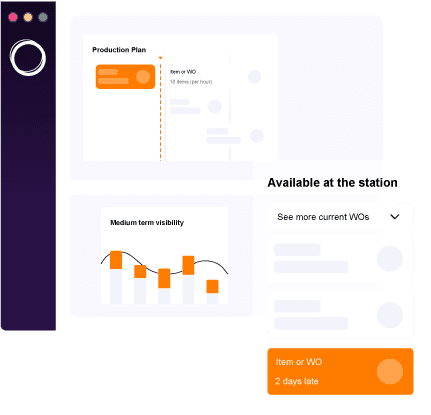ERP, MES, MRP, Oplit, who does what?
12/07/2023
Industrialists today have several tools at their disposal to manage and optimize their production. ERP, MES, MRP software, many acronyms but little clarity in this market, so let's try to see more clearly.
Let's start with the ERP.
The ERP (enterprise resource planning) is a global system for the entire company whose main purpose is resource management. There are specific ERPs for companies engaged in manufacturing activities: the manufacturing ERPs (previously called MRP).
They especially allow for the management of inventories, planning, orders, and quality control. These features will immediately help you increase your productivity, customer satisfaction, and compliance, automate processes, and centralize your data.
However, production flow management or machine management is not the core business of the ERP. The ERP is therefore a must for any industrial company, but there are other technologies that will complement it by integrating perfectly and will be able to manage capacity load issues or maintenance in a much more agile and efficient manner.
This is where the MES comes into play.
The MES (manufacturing execution system) provides the link between the ERP and the process control systems present on the shop floor.
In terms of functionality, an American and international standard has been established, the ANSI/ISA-95 standard, which defines the 11 essential functions of the MES:
Ultimately, the functionalities of the MES can be divided into two parts: Resources and Machines.
Specifically, the "resources" part of the MES allows for managing the presence of teams, as well as tracking operations, traceability, documentation, quality, supplies, and measuring overall productivity.
Finally, the "machines" part of the MES allows for managing maintenance and overall equipment efficiency (OEE).
Unlike many ERPs, data is automatically collected by the MES and consolidated, allowing for an overview of the workflows and their performance in real-time. Teams can then focus a bit more on continuous improvement.
Finally, there are MRP software.
The MRP (Material Requirements Planning) software will allow you to efficiently manage your production flows whether you are a discrete manufacturing company producing in large or small volumes - working in make-to-order or make-to-stock.
The MRP software incorporates both strategic and operational vision, which is why it will help you achieve your PIC (Industrial and Commercial Plan) as well as your PDP (Production Plan) and PDC (Load Plan).
At a time when resilience is key to successfully staying the course against multiple unforeseen events, MRP will provide you with agility as well as flexibility.
MRP solutions can integrate the processes specific to each company, and allow you to configure their structure, their ranges, and load points since each production site is unique and has its own characteristics.
Specifically, MRP solutions allow for balancing load capacity, performing optimized constrained scheduling, managing work in progress, and tracking orders and production in general.
Finally, they also allow you to monitor the performance of the supply chain as well as that of all production sites (multi-site view).
And what about Oplit?
Oplit is a SaaS platform that is similar to MRP software because managing production flows is its core business.
With the goal of enabling each actor in the production chain to gain autonomy by having the means to make the best possible decision at any moment, Oplit is also an excellent inter-departmental communication tool.
Oplit also enhances certain functionalities of traditional MRP software by pushing them further. Indeed, you will be able to simulate load capacity and scheduling. Once the simulation is validated, you can send it to the operators on the ground so they can understand the priorities to be addressed. The order of priority can be modified based on rules tailored to each load point.
Finally, regarding performance, it will be possible for you to track your orders and your production objectives, whether frozen or not, in real-time. You will be able to monitor your analytics and the history of your data across one or multiple production sites simultaneously. This data history is valuable as it will allow Oplit to provide you with predictability, especially concerning the completion dates of the orders.

Make a choice among all these solutions.
Today, there is a plethora of solutions on the market where the lines between ERP, MES, and GPAO software are sometimes thin (ERP-GPAO...). Some modules are basic while others include a multitude of features. Therefore, it is crucial to remain vigilant about the quality of the software as well as the quality of the support. Implementation is always a complex step, and one needs to be well supported. Finally, modularity is also an essential point because your needs may evolve.
Ultimately, when searching for software, you must think about your current issues as well as your future issues. Anticipate as much as possible. The money and time spent during the deployment of such tools are often significant. Changing them is a monumental project, so do not rush.
Inventory the solutions, modules, and features already deployed on your site, conduct a needs assessment, produce a report of surprising findings, diagnose your company’s production, and set objectives!
What has not been working until now? What is missing to optimize your production management? Also, consult all stakeholders within your company so that the new tools serve the greatest number.
Finally, if possible, draft a specifications document and structure your benchmark.
In conclusion.
Ultimately, the essential point for industrial sites will be to approach the issue of digitalizing their supply chain by functionality based on today's objectives as well as those of tomorrow. They will need to ensure the quality of the software but also the service/support provided by the vendors. Lastly, they will need sponsors within their teams who are capable of promoting the deployed solutions to boost their adoption rate.




